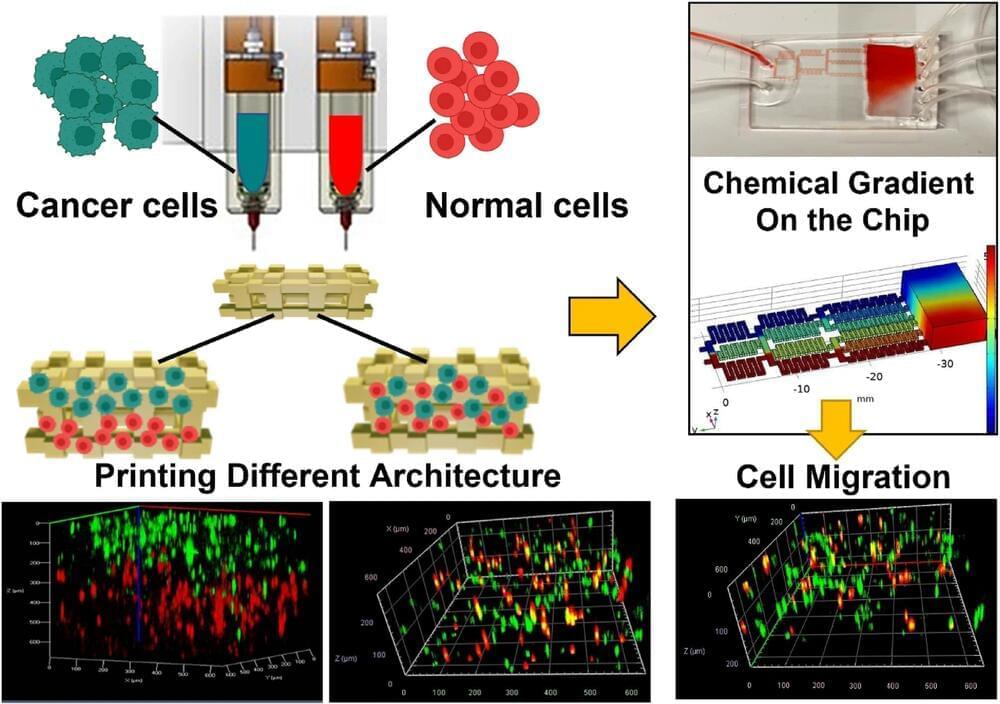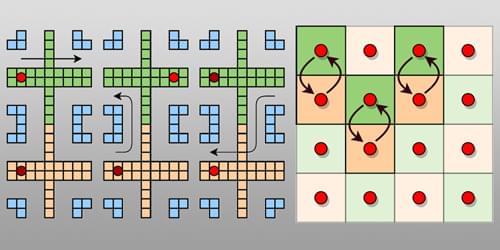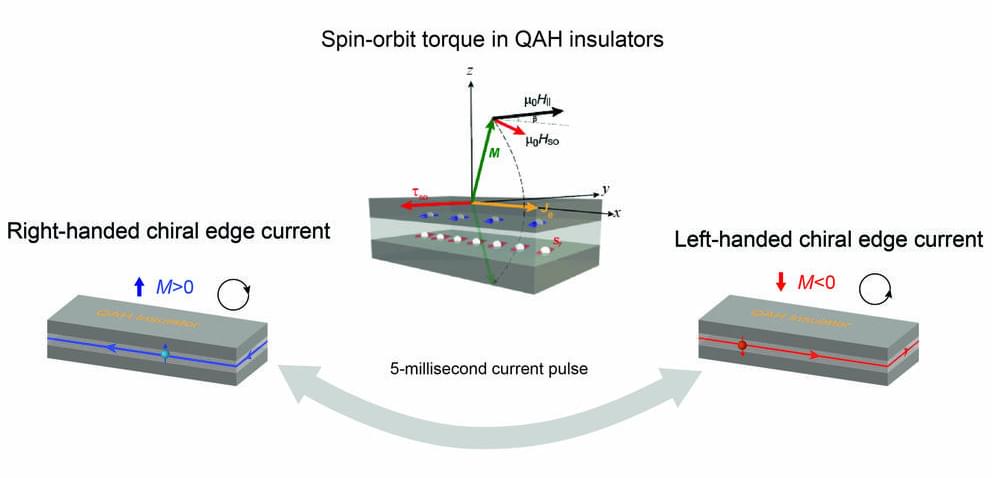Strings of atoms create qubits that interact via superatoms.



An international team of interdisciplinary researchers has successfully created a method for better 3D modeling of complex cancers. The University of Waterloo-based team combined cutting-edge bioprinting techniques with synthetic structures or microfluidic chips. The method will help lab researchers more accurately understand heterogeneous tumors: tumors with more than one kind of cancer cell, often dispersed in unpredictable patterns.
The research, “Controlled tumor heterogeneity in a co-culture system by 3D bio-printed tumor-on-chip model,” appears in Scientific Reports.
Traditionally, medical practitioners would biopsy a patient’s tumor, extract cells, and then grow them in flat petri dishes in a lab. “For 50 years, this was how biologists understood tumors,” said Nafiseh Moghimi, an applied mathematics post-doctoral researcher and the lead author of the study. “But a decade ago, repeated treatment failures in human trials made scientists realize that a 2D model does not capture the real tumor structure inside the body.”

The simulated universe theory implies that our universe, with all its galaxies, planets and life forms, is a meticulously programmed computer simulation. In this scenario, the physical laws governing our reality are simply algorithms. The experiences we have are generated by the computational processes of an immensely advanced system.
While inherently speculative, the simulated universe theory has gained attention from scientists and philosophers due to its intriguing implications. The idea has made its mark in popular culture, across movies, TV shows and books—including the 1999 film “The Matrix.”
The earliest records of the concept that reality is an illusion are from ancient Greece. There, the question “What is the nature of our reality?” posed by Plato (427 BC) and others, gave birth to idealism. Idealist ancient thinkers such as Plato considered mind and spirit as the abiding reality. Matter, they argued, was just a manifestation or illusion.

The headline challenge for building a quantum computer is well known: the quantum states exhibited by such a computer’s computational building blocks—its qubits—must be long-lived and robust against disruption by the environment. But even the most resilient qubits are useless for quantum computing if they can’t be combined in sufficient numbers. Maciej Malinowski at Oxford Ionics, UK, and his colleagues have now tackled this problem through a more efficient architecture for controlling qubits [1]. Applying their “Wiring using Integrated Switching Electronics” (WISE) approach to trapped-ion qubits specifically, they present a design for a quantum computer with 1,000 qubits—far more than the few tens of qubits that make up the largest commercially available trapped-ion device currently available.
Trapped-ion quantum computers share much of their solid-state chip technology with modern classical computers, but they have added complexity. Whereas the bits in a classical computer are written and read using simple signals sent via a small number of electrodes, the qubits in a trapped-ion computer are controlled using subtler, more varied signals, which are delivered by as many as ten separate electrodes per qubit. As the number of qubits in a quantum computer increases, fitting these electrodes and signal generators on the chip—not to mention dissipating the heat that they generate—gets more difficult.
In their WISE approach, Malinowski and his colleagues use fewer signal generators and move them off the chip. Instead of every individual qubit having its own dedicated control structure, the signal from one signal generator is relayed to multiple qubits via a small number of local switches. Malinowski says that a trapped-ion quantum computer employing their control method could be built using existing semiconductor fabrication techniques.

Holograms provide a three-dimensional (3D) view of objects, offering a level of detail that two-dimensional (2D) images cannot match. Their realistic and immersive display of 3D objects makes holograms incredibly valuable across various sectors, including medical imaging, manufacturing, and virtual reality.
Traditional holography involves recording an object’s three-dimensional data and its interactions with light, a process that demands high computational power and the use of specialized cameras for capturing 3D images. This complexity has restricted the widespread adoption of holograms.

Some have described the last several millennia of human dominion over the earth’s resources as the anthropocene, deriving from the Greek “anthropo” meaning human, and “cene” meaning recent. The last century in particular has been dubbed the fourth industrial revolution, due to the pace of technological innovation ushered in by the advent of computers in the middle of the 20th century.
In the past seventy years, computation has transformed every aspect of society, enabling efficient production at an accelerated rate, displacing human labour from chiefly production to services, and exponentially augmenting information storage, generation, and transmission through telecommunications.
How did we get here? Fundamentally, technological advancement draws on existing science. Without an understanding of the nature of electromagnetism and the structure of atoms, we wouldn’t have electricity and the integrated circuitry that power computers. It was only a matter of time, then, before we thought of exploiting the most accurate, fundamental description of physical reality provided by quantum mechanics for computation.

Windows 11 Pro ships with a security feature that could severely hamper your solid-state drive’s performance. Fortunately, it is easy enough to turn off but some might not even know it is enabled by default.
BitLocker encryption in Windows 11 Pro is designed to safeguard data and ensure it is only accessible by authorized individuals, but it comes with a steep performance penalty. To find out how much of an impact it could have, Tom’s Hardware recently conducted tests under three scenarios: unencrypted (no BitLocker), software-enabled BitLocker (the Windows 11 Pro default), and hardware-based BitLocker.
The crew used a 4 TB Samsung 990 Pro SSD running Windows 11 Pro (22H2, with all patches installed) paired with an Intel Core i9-12900K and 32 GB of DDR4 RAM for testing.


A new electrical method to conveniently change the direction of electron flow in some quantum materials could have implications for the development of next-generation electronic devices and quantum computers.
A team of researchers from Penn State developed and demonstrated the method in materials that exhibit the quantum anomalous Hall (QAH) effect—a phenomenon in which the flow of electrons along the edge of a material does not lose energy. The team described the work in a paper in the journal Nature Materials.
“As electronic devices get smaller and computational demands get larger, it is increasingly important to find ways to improve the efficiency of information transfer, which includes the control of electron flow,” said Cui-Zu Chang, Henry W. Knerr Early Career Professor and associate professor of physics at Penn State and co-corresponding author of the paper. “The QAH effect is promising because there is no energy loss as electrons flow along the edges of materials.”

The super-special material graphene continues to surprise and fascinate scientists, this time revealing a rare electronic state termed ‘ferro-valleytricity’, which occurs when graphene is stacked up in a particular five-layer combination.
When in this new state, the graphene stack exhibits weird and wonderful magnetic and electronic behavior, as reported by researchers from the Massachusetts Institute of Technology (MIT), Harvard University, and the National Institute for Materials Science in Japan.
Using graphene in this way could help in the development of both classical and quantum computers, according to the team, especially in terms of creating data storage solutions that offer large capacities but that also need relatively little energy to run.